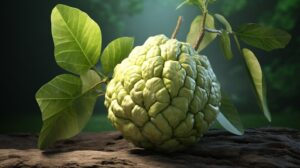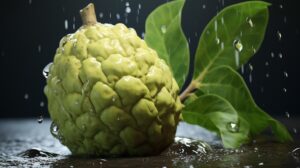Physical Address
304 North Cardinal St.
Dorchester Center, MA 02124
Physical Address
304 North Cardinal St.
Dorchester Center, MA 02124

The custard apple, also known as cherimoya or soursop, is a delicious and nutritious tropical fruit grown in tropical and subtropical climates. This exotic fruit has a unique creamy texture and sweet, tangy flavor.
This article provides a complete guide to eating custard apples including:
Custard apples belong to the Annona genus and Annonaceae plant family which includes:
| Common Name | Scientific Name |
|---|---|
| Cherimoya | Annona cherimola |
| Soursop | Annona muricata |
| Sugar apple | Annona squamosa |
| Atemoya | Cherimoya x Sugar apple |
This tropical fruit guide will cover everything you need to know about choosing, preparing, and serving this vitamin-, antioxidant- and fiber-rich superfruit.

Picking out ripe, ready-to-eat custard apples is an important first step. Here are tips for identifying ripe custard apples:
The best season to find ripe custard apples is in late summer through early fall in tropical and subtropical climates. However, the harvest season can vary:
There are subtle flavor and texture differences among custard apple varieties:
Choose ripe, undamaged fruits with an appealing aroma. Custard apples are highly perishable so eat as soon as possible once ripe.
Follow these steps for properly cutting open a fresh custard apple:
Wash the fruit under cool running water to remove dirt and debris.
Cut the fruit in half lengthwise around the middle using a sharp knife.
Twist the halves gently to separate.
Use a spoon to scoop out the sweet flesh and large seeds.
The skin or peel can be removed either before or after scooping out the insides.
Tips for cutting custard apples:
Use a sharp, thin-bladed knife for clean cuts.
Be gentle when prying apart the halves to keep the flesh intact.
A serrated bread knife works well to cut around the middle.
Cut over a bowl or plate to catch the juices and flesh.
Discard the tough, inedible skin, unless using for crafts or compost.
Take care when handling cut custard apples since the flesh is delicate and easily bruised. Enjoy the sweet, aromatic flesh as soon as possible after cutting.

The edible interior of custard apples can be enjoyed in different ways:
Scoop the soft, creamy flesh out of the peel using a spoon.
The texture is described as:
The flavor is sweet and mild with notes of:
The flesh can be enjoyed:
Custard apples contain a good amount of natural sugar so they taste sweet even when ripe.
They have a mildly acidic, subacid flavor when perfectly ripe.
Scoop and enjoy the luscious custard apple flesh as a nutritious snack or dessert ingredient. The velvety texture and sweet, tropical flavor make it a delicious treat!
Custard apples are highly perishable. Follow these guidelines for storing leftover custard apple flesh:
Refrigerate any unused flesh in an airtight container.
Custard apple flesh will keep for 2-3 days in the refrigerator.
To extend shelf life, custard apple flesh can be frozen:
Scoop flesh into freezer bags or containers.
Freeze for up to 6 months.
Thaw in the refrigerator before using.
The flesh can also be blended into a puree before freezing.
Frozen custard apple puree is great for:
For best quality, consume any leftovers within 1-2 days. The flavor and texture declines quickly.
Proper refrigeration and freezing allows you to enjoy custard apple flesh for longer. Handle the perishable tropical fruit gently and use as soon as possible.
Custard apples provide an impressive array of nutrients and health benefits:
Excellent source of antioxidants like vitamin C and polyphenols.
Contains key vitamins and minerals:
High water content helps hydrate.
Low glycemic index makes it suitable for diabetics.
Fiber aids healthy digestion.
Potential anti-inflammatory, anti-microbial, and anti-cancer effects due to antioxidants.
May support heart health and immune function.
Nutrition facts per 100g:
| Nutrient | Amount |
|---|---|
| Calories | 94 |
| Carbs | 24g |
| Sugar | 20g |
| Fiber | 3g |
| Vitamin C | 20% DV |
| Vitamin B6 | 10% DV |
| Magnesium | 12% DV |
With an impressive nutrient profile, custard apples are a nutrition powerhouse and tropical superfruit!
Custard apples require specific growing conditions to thrive:
Climate – Tropical or subtropical climates with temperatures above 50°F. Provide frost protection.
Pollination – Some self-pollinating varieties but improved fruit set with cross-pollination. Hand pollination may be needed.
Planting
Space trees at least 10-20 ft apart.
Dig hole and amend soil with compost or manure.
Water newly planted trees regularly until established.
Fertilizer – Fertilize with nitrogen and potassium in spring and summer.
Pests – Watch for mites, scale, mealybugs. Monitor for fruit flies.
Diseases – Prevent fungal issues like anthracnose, root rot.
Growing zones:
USDA zones 10-11
Can grow in zones 8-9 using containers to protect from cold.
With proper climate, soil prep, and care, custard apples can thrive in a home orchard or landscape.
Custard apples are a unique and impressive tropical fruit. To recap key points:
Identify ripeness – Choose fruits that yield slightly, aroma sweetly, and have optimal exterior color.
Cut carefully – Use a sharp knife to cut in half lengthwise. Scoop out flesh.
Ideal texture – Flesh is smooth, creamy, velvety when ripe.
Flavor – Sweet, mildly acidic, and tropical aromas.
Eat raw or use in smoothies, desserts, juices.
Store properly – Refrigerate and use within 2-3 days or freeze puree.
Nutrition powerhouse – Rich in antioxidants, vitamins, minerals.
Grow in tropical climates – Needs warm temps, space, fertilizer and pest management.
With proper handling, cutting, and storage, luscious custard apples provide a delicious and nutritious tropical treat! Follow this guide for experiencing the unique flavors and textures of this exotic fruit.

I’m Rachel Cooper, the brain and heart behind AboutWeirdFruits. If you’re here, you probably share the same insatiable curiosity for the fascinating world of exotic fruits that I do. From the spiky Durian to the unique Buddha’s Hand, I’ve been captivated by the diversity, flavors, and benefits these rare fruits bring into our lives.